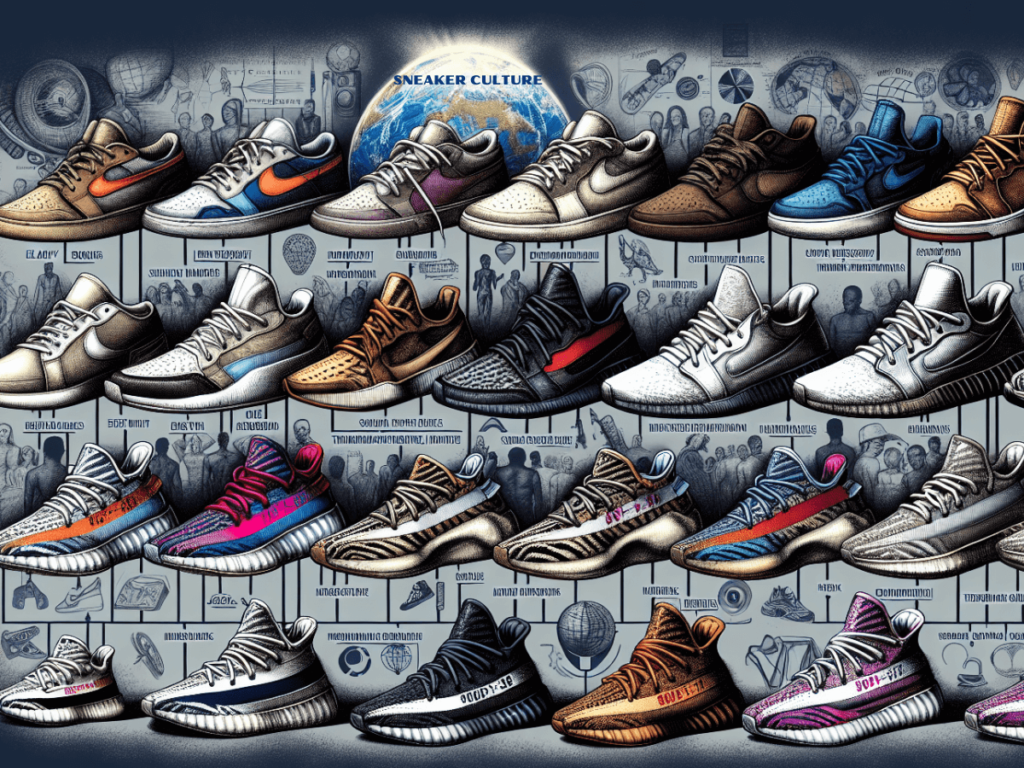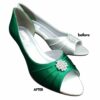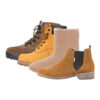Sneakers started off as simple athletic footwear but have since evolved into omnipresent fashion staples ineradicable from modern pop culture. Discover the evolution of sneaker culture and how what used to be mere gym gear transcended to hold a substantial fashion pedigree.
Introduction
Sneakers have long transcended their initial design as humble athletic footwear, morphing into a crucial element of global fashion and cultural identity. Originally crafted to provide support and comfort during physical activities, they have shifted gears, becoming a heavyweight in the fashion. This transformation is not just about aesthetic appeal or market trends; it’s a reflection of the evolving dynamics of cultural values, technological advancements, and economic factors.
In this article, we trace the fascinating journey of sneakers from their origins in athletic utility to their current role as indispensable fashion essentials. Each step of the way, these versatile shoes have mirrored changes in society, often acting as silent, yet immensely powerful, cultural commentators. What lies underneath this shift is not just a tale of functionality or style, but a profound commentary on the societal fabric that we navigate daily. Join us as we delve deeper into this evolution, unpacking how a simple sports accessory rose to command such a substantial sartorial and cultural pedigree.
Early Beginnings: The Birth of Sneakers
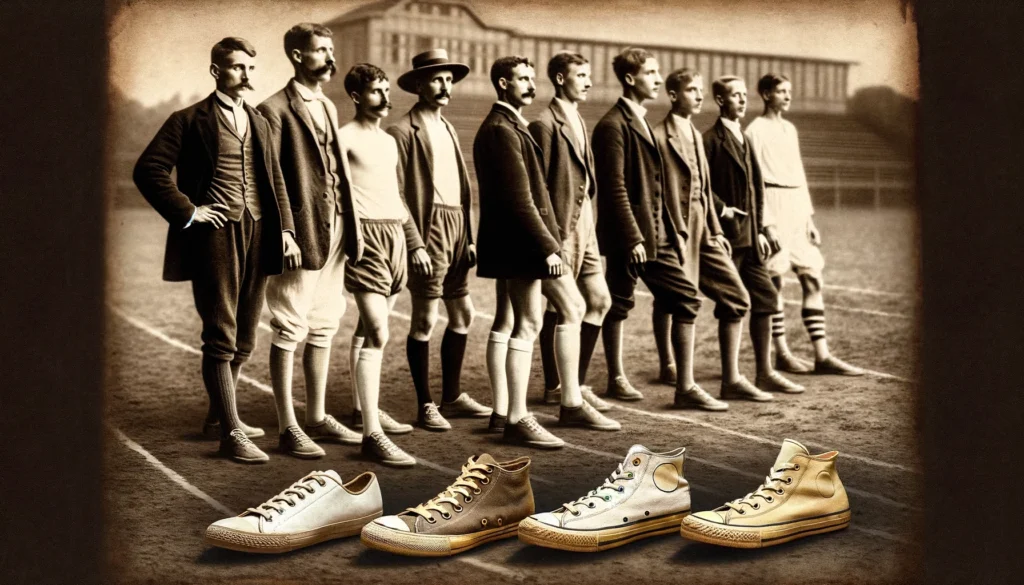
The Rise of Athletic Footwear
The humble beginnings of sneakers trace back to the late 19th and early 20th century, a period marked by rapid industrial advancements and changing social dynamics. Initially developed as innovative athletic footwear, their primary aim was to offer comfort and enhanced performance during physical activities. It was an era when people started taking sports seriously, necessitating gear that could keep up with the increasing physical demands.
Design and Functionality
The earliest versions of sneakers featured a simple design—a canvas upper and a rubber sole. They were fundamentally engineered to provide athletes with grip and flexibility on various playing fields. The term “sneaker” itself emerged from how quietly the rubber soles allowed wearers to move, contrasting sharply with the noisy, clacking leather shoes commonly worn at the time.
Market Innovators
One of the first shoe companies to capitalize on this burgeoning market was the U.S. Rubber Company, which introduced Keds in 1916. These shoes were advertised as the ideal footwear for athletes, touting their durability and comfort. Around the same era, Converse released the All Star, designed specifically for basketball players, and it later became iconic not just in sports but in American culture.
Transition Beyond Sports
Sneakers, in these formative years, were strictly functional. They were pieces of equipment supporting physical endeavors rather than fashion statements. This focus helped lay the foundations for what would become a significant transformation, as these practical shoes gradually stepped off the tracks and courts and into everyday life. As we move forward into examining their rise through sports culture, it’s essential to recognize that the sneaker’s initial purpose as functional footwear for athletes set the stage for its later roles in society.
The Rise of Sneaker Culture in Sports
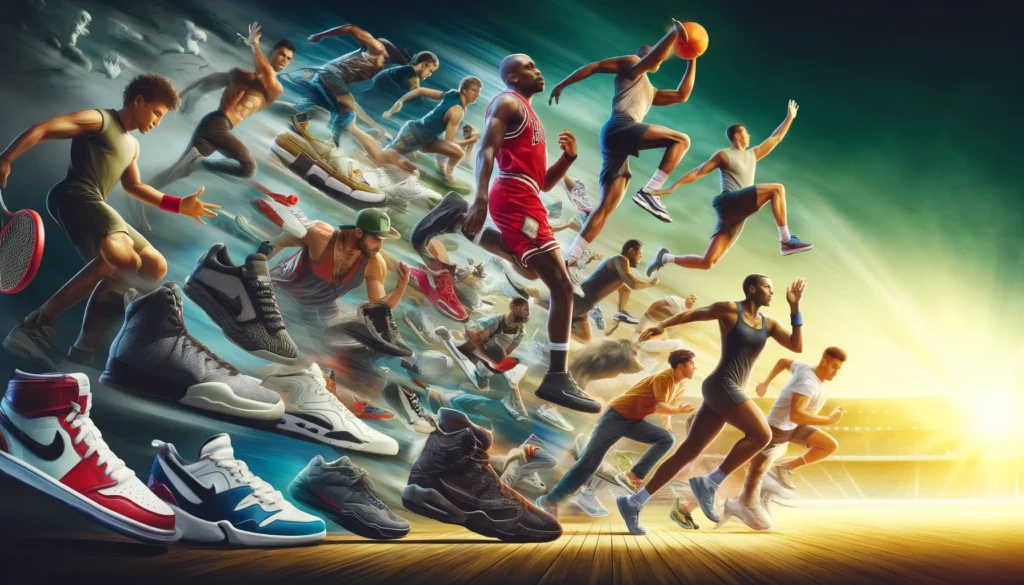
Sneakers practically sprinted from their inception directly into the athletic arena, where they became more than just footwear; they became a crucial part of sports culture. Initially, sneakers were tailored to provide athletes with comfort and enhanced performance during competitions. Over the decades, however, they transcended functionality and wove themselves into the very fabric of sports’ most iconic moments.
Let’s lace up and delve deeper into this transition. Picture the 1936 Olympics, often marked as a significant milestone in sneaker history. Here, Adidas founder Adi Dassler personally crafted shoes for the legendary sprinter Jesse Owens, who went on to win four gold medals. This event not only showcased the importance of specialized athletic footwear but also demonstrated how integral these shoes were to achieving peak athletic performance.
The Perfect Relationship
Fast forward through time, and the involvement of sneakers in sports kept growing. With each leap and dunk, sneakers were there, evolving. By the mid-20th century, they were synonymous with burgeoning sports stars, who not only pushed the limits of what athletes could achieve but also influenced which sneakers were on everyone’s wish list. The phenomenon of basketball player endorsements, for instance, took on a new dimension with players like Michael Jordan. His Air Jordan line, launched in the mid-’80s, didn’t just sell a product; it sold a basketball legacy encased in stylish, desirable sneakers. This shoe line proved so popular that it formed its own sub-brand of Nike and fundamentally changed how athlete endorsements influence fashion and consumer preferences.
Besides endorsements, major sporting events themselves began acting as runways for the latest sneaker innovations. Athletic shoe companies saw these events as golden opportunities to advertise new technology, from air-cushioned soles to energy-returning boost particles. These technological advancements were not just about creating better athletes; they were also about creating an entire spectacle around what athletes wore during their performances.
From these historical snapshots, it’s clear that the rise of sneaker culture in sports was not just about the shoes but the stories they told and the heroes they were associated with. This melding of functionality, personal achievement, and style helped sneakers stride confidently from the tracks and courts into mainstream culture, with a chutzpah that remains unabated. Sneakers became synonymous not just with the game but with the flair and identity of the players themselves — transforming every jump, sprint, or casual walk into a cultural statement.
Sneakers Break into the Mainstream
The tipping point for sneakers’ transition from sports arenas to the streets came during the latter half of the 20th century. This period marked a significant shift as sneakers began to be perceived not just as utilitarian sports gear but as symbols of identity and self-expression accessible to the average person. Key factors that facilitated sneakers breaking into the mainstream include media influence and celebrity endorsements.
Television played a pivotal role in bringing the sneaker culture into living rooms around the world. As sports events became regular television features, viewers not only became fans of the sports but also the gear associated with them. Sneakers worn by athletes gained iconic status, and fans rushed to emulate their sports heroes’ style, wearing the same models of sneakers.
Celebrity endorsements added another layer of allure to sneakers. When basketball player Michael Jordan released his Air Jordan sneakers in 1985, it wasn’t just the technological advancements of the shoe that captured the public’s imagination—it was also Jordan’s charismatic persona and athletic prowess. The success of the Air Jordan line set a precedent for future collaborations between athletes and sneaker brands.
Street Culture Takes Over
Moreover, sneakers began appearing in the context of emerging youth cultures, particularly within the realms of hip hop and skateboarding, during the 1980s and 1990s. Icons like Run DMC endorsed Adidas Superstars, not just wearing them but also rapping about them, which cemented sneakers as a staple of street fashion. Similarly, skateboarding culture adopted sneakers for their functionality and eventually for their style, influencing casual fashion.
This mainstream adoption was further spurred by the evolution of marketing strategies. Sneaker ads were no longer just about performance; they told stories of rebellion, innovation, and fashion. This storytelling approach made sneakers appealing to a broader audience, extending far beyond the realm of athletics.
The cross-pollination of sneakers into daily life was complete when they became regular items at fashion retailers and not just sports outlets. As they transitioned into an everyday essential, sneakers echoed the changing cultural landscapes, illustrating how integral they had become not only as functional items but as crucial elements of personal and social identity.
Sneakers as a Symbol of Subcultures

Sneakers have not merely walked; they’ve sprinted across the vast terrains of various subcultures, each adoption further weaving them into the societal fabric, influencing both their design and skyrocketing their popularity. From the underground skate parks to the pulsating floors of hip-hop dance battles, sneakers have become emblematic of more than just practical footwear; they represent the ethos and rebellious spirit of diverse groups across the social spectrum.
Riding the Wave with Skaters
In the skateboard community, sneakers transcended their basic utility to become crucial elements of identity and performance. Brands like Vans and DC Shoes fashioned durable and stylish kicks that offered the grip and flexibility needed for skaters to perform ollies and kickflips. This subculture’s embrace did more than boost sales; it shaped the aesthetic of sneakers, making ruggedness and comfort desirable traits even outside the skate world.
Bouncing to the Beat of Hip-Hop
Meanwhile, the hip-hop scene saw sneakers as a canvas for self-expression and an indicator of prestige. When b-boys and b-girls spun on dance floors, the flash of their sneakers was as compelling as their moves. Iconic shoes like the Adidas Superstar became synonymous with the culture, partly thanks to endorsements from legends like Run DMC. The group’s hit song “My Adidas” in 1986 underscored the deep emotional and cultural connection between hip-hop and sneaker brands, pushing sneakers into a symbol of urban identity.
Electronic Beats and Street Feats
The electronic music scene and its associated rave culture also played a part in normalizing sneakers in nightclubs and festivals, spaces traditionally dominated by more formal attire. Ravers valued sneakers for their comfort during long dance sessions, and bright, neon-colored designs aligned perfectly with the vibrant, often psychedelic fashion favored by this community.
Each of these subcultures has not only shaped the design and function of sneakers but also their cultural significance. As they were adopted by diverse groups, sneakers’ very connotations transformed. They became symbols of resistance, non-conformity, and collective identity, contributing significantly to their metamorphosis from purely sportswear to staple elements in the global fashion wardrobe. In essence, sneakers tell the story of a walk through diverse cultural landscapes, each step marked by an adaptation that reflects the dynamic human experience.
Impact of Technology on Sneaker Design and Functionality

Over the years, technological innovation has not only shaped the sneaker design but also revolutionized its functionality, turning humble athletic shoes into high-tech footgear sought by both athletes and fashion enthusiasts. Here’s how advancements in technology have sculpted the landscape of modern sneakers:
One of the earliest significant tech introductions in sneakers was the development of air-cushioned soles. This breakthrough, pioneered by Nike with their Air technology in the late ’70s, utilized encapsulated air to offer enhanced cushioning. It dramatically increased the comfort and performance capabilities of sneakers, catching the eye of both everyday wearers and professional athletes.
Modern Technology of Sneakers
Fast forward to the 2000s, and we’ve seen the integration of smart technology into sneakers. Take Adidas’ introduction of the miCoach Speed Cell, for example. Placed in a cavity of the shoe’s sole, this tiny device captures and stores an incredible amount of data, including speed, distance, and sprint times. This allowed athletes to fine-tune their performance through detailed analytics, merging physical fitness with digital precision.
Furthermore, the rise of 3D printing technology has empowered brands like Under Armour and New Balance to experiment with 3D-printed soles, which can be customized to a wearer’s foot contour and running style, offering unprecedented personalization and enhancing performance while potentially reducing injury risks.
These technological advancements not only made sneakers more functional but also transformed their aesthetic appeal and market positioning. From glow-in-the-dark soles to self-lacing systems, inspired by the sci-fi movie “Back to the Future,” technology has turned sneakers into both a gadget and a fashion piece. Each feature does not just serve a practical function but also acts as a selling point in a fiercely competitive market.
As we continue to move forward, the integration of technology in sneaker design is poised to become even more sophisticated, blurring the lines between fashion, functionality, and futurism. In this light, the sneaker is no longer just footwear but a canvas of innovation, reflecting the wearer’s style while offering cutting-edge technology right at their feet.
Fashions’ Embrace: Sneakers on the Runway
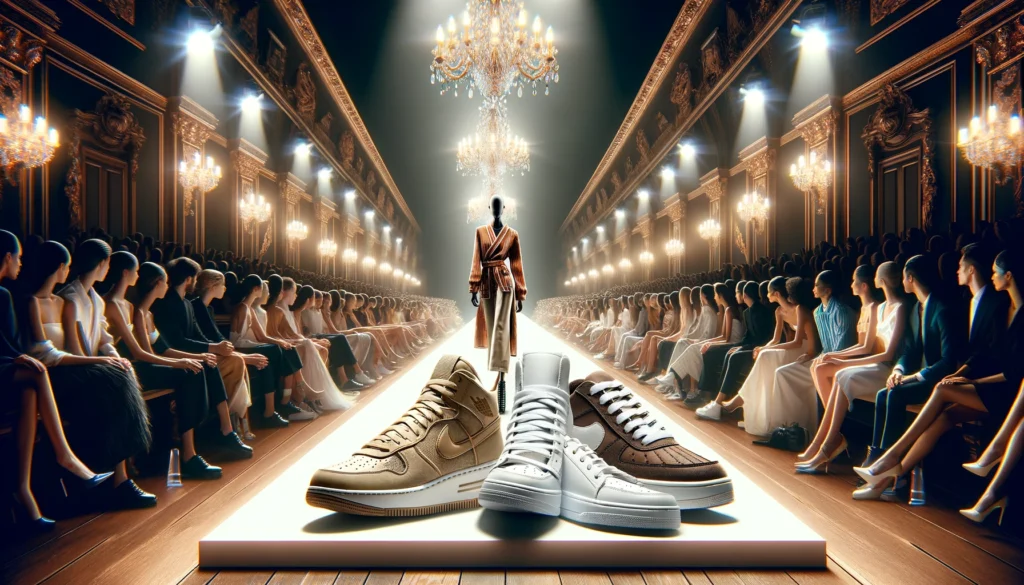
Sneakers, once confined to gym floors and athletics tracks, have confidently strutted onto the high-fashion catwalks, rewriting style norms and blending comfort with haute couture. This embrace by the fashion world was not an overnight phenomenon but a gradual integration that mirrored society’s evolving perspective on style and comfort.
The Change
The journey of sneakers into the echelons of high fashion gained significant momentum in the late 20th century. It was then that the barriers between ‘high’ and ‘low’ culture began to blur. Sneakers started appearing in unexpected places, from high-profile fashion shows to being paired with haute couture garments. This shift was particularly visible during major fashion weeks where once-rigid dress codes became more inclusive of contemporary street styles, allowing sneakers to become a celebrated element of modern attire.
Key to this transition were the collaborations between eminent sports brands and renowned fashion designers. For instance, when Nike partnered with Michael Jordan creating Air Jordans, it wasn’t just a win for athletic footwear but also a monumental step towards positioning sneakers within the lifestyle and fashion segments. Similarly, collaborations between Adidas and designers like Stella McCartney or Jeremy Scott brought athletic sneakers into the spotlight as versatile fashion staples, suited not only for sports but for everyday elegance.
Runway Ready
The presence of sneakers on runway shows such as those of Chanel and Louis Vuitton further cemented their status as a viable choice for any fashion-forward wardrobe. These events, often highlighted by live streams and extensive media coverage, showcased sneakers paired with everything from casual wear to luxury evening dresses, thus pushing the boundaries of traditional fashion practices and expectations.
Moreover, this fashion transformation also reflected a broader change in societal attitudes where the merging of functionality and style became paramount. This blend has not only changed how designers approach footwear but also how individuals curate their personal style, making fashion both accessible and personal.
Ultimately, the ascension of sneakers onto the runways represents more than a mere trend; it signifies a pivotal shift in fashion ideology. It champions a new era where comfort meets chic. Where sneakers are as much at home on the red carpet as they are on the street.
Sneakers as Fashion Statements Today
Today, sneakers are not just athletic footwear; they have become pivotal fashion elements in everyone’s wardrobe, ranging from streetwear enthusiasts to high-end fashion influencers. The rise of sneakers as a dominant fashion accessory was gradual and deliberate, reflecting their significant and growing influence in contemporary culture.
Sneaker Trends and Cultural Impact
Contemporary sneaker trends vividly illustrate how these shoes have maintained their status as cultural icons:
- Limited-Edition Releases: Sneakers often become the center of attention during limited-edition drops, which helps maintain their status as collectible items.
- High-Fashion Collaborations: Partnerships with high-end fashion designers or celebrities, such as Adidas’s collaboration with Kanye West for the Yeezy line or Nike’s team-up with Travis Scott, amplify sneakers’ fashion credibility.
- Celebrity Influence: Celebrities launching their sneaker lines also contribute massively to the desirability and influence of sneakers in the fashion industry.
Personal Expression and Customization
Sneakers also serve as a platform for personal expression and individuality:
- Style and Preference Canvas: They allow wearers to showcase their unique style and preferences distinctly and vividly.
- Popularity of Customization: The rise in sneaker customization underscores a growing desire among individuals to own footwear that is unique, personal, and reflective of their creative spirit.
Environmental Sustainability
The sneaker industry is also embracing environmental sustainability:
- Use of Recycled Materials: More brands are incorporating recycled materials into their sneakers, reflecting a commitment to reducing environmental impact.
- Eco-friendly Options: The introduction of vegan and eco-friendly sneakers aligns with a broader societal shift towards sustainability, appealing to environmentally conscious consumers.
Conclusion
In summary, sneakers have transcended their initial athletic purposes to become symbols of fashion, culture, personal identity, and environmental responsibility. As they continue to evolve, it’s clear that sneakers will remain pivotal in both the fashion world and the broader cultural landscape, continuing their legacy as more than just footwear but as integral elements of expression and innovation.
The Global Market and Future Trends

The evolution of sneaker culture has transcended geographic boundaries. It is a robust global market driven by an ever-growing community of aficionados. Today, sneakers are not just commonplace in streets across continents but are also significant market movers. In 2021 alone, the global sneaker market was valued at around $79 billion. Moreover, with projections pushing this figure towards $120 billion by 2026. This highlights the increasing economic impact of this footwear genre.
The remarkable global influence of sneaker culture can be attributed to several factors including globalization, digital marketing, and the rise of social media platforms. Brands leverage these platforms not only to launch new models but to also ignite and participate in broader conversations around fashion and identity. This engagement has made sneakers a ubiquitous presence, creating a universal language of style and empowerment.
Consumer Behaviour
Consumer behavior, especially among Millennials and Gen Z, shows a strong preference for sneakers that embody authenticity and story-telling, rather than just serving a functional or aesthetic purpose. This shift has prompted manufacturers to innovate continuously, not just in design but also in sustainability practices, catering to a more environmentally conscious buyer.
Looking ahead, the future of sneakers in fashion and culture appears resilient and vibrant. We’re likely to see greater fusion between technology and footwear, with smart sneakers equipped with enhanced functionalities becoming more prevalent. Moreover, as the push for sustainability grows, there could be an increased focus on eco-friendly materials and more circular manufacturing processes.
Future Integration with Virtual Reality?
Fashion insiders speculate that the integration of virtual reality and augmented reality into the shopping experience will further customize how we select and wear sneakers, possibly affecting future designs and consumer preferences. As both a fashion statement and a cultural icon, the sneaker’s journey is far from over; it’s just putting on new laces for an updated journey into the future’s wardrobe.
For enthusiasts and casual consumers alike, the evolving dynamics of sneaker culture offer a fascinating lens through which to view global market trends and predict cultural shifts. Join us at Shoewash Supreme for more insights and expert guidance on keeping your cherished sneakers in top-notch condition, whether they’re fresh off the runway or tested on the streets.
Conclusion
In tracing the journey of sneakers from their humble beginnings as purpose-built athletic shoes to their current status as indispensable fashion icons, we’ve navigated through a fascinating evolution. Sneakers have transcended their initial utility to become powerful cultural symbols, reflecting and even influencing societal shifts and fashion trends. Each phase in the history of sneakers, from their roots in sports to their celebration on high fashion runways, underscores their versatility and enduring appeal.
This metamorphosis from functional sports equipment to a staple of fashion wardrobes worldwide does more than just highlight changing aesthetic preferences. It illustrates a broader shift in cultural values towards a more casual, personalized style of expression. Today, sneakers are more than just footwear; they are a means through which individuals communicate identity, affiliation, and style.
What We Can Expect
As we look to the future, the sneaker’s role within both culture and fashion seems poised to expand even further. With continuous innovations in design and functionality, coupled with their entrenched status in various subcultures and mainstream media, sneakers will undoubtedly continue to be a significant part of our social fabric and style lexicon.
At Shoewash Supreme, we recognize the profound impact that sneakers have had on fashion and culture. By caring for every pair, from vintage finds to the latest drops, we help our customers preserve not just their shoes but the stories they carry. Dive into our world where every sneaker tells a story, and stay tuned for more insights on how these beloved pieces continue to shape our world. Explore our services and the rich culture of footwear at Shoewash Supreme. Thanks for reading our article on the evolution of sneakers culture.
Tags: shoewash supreme
